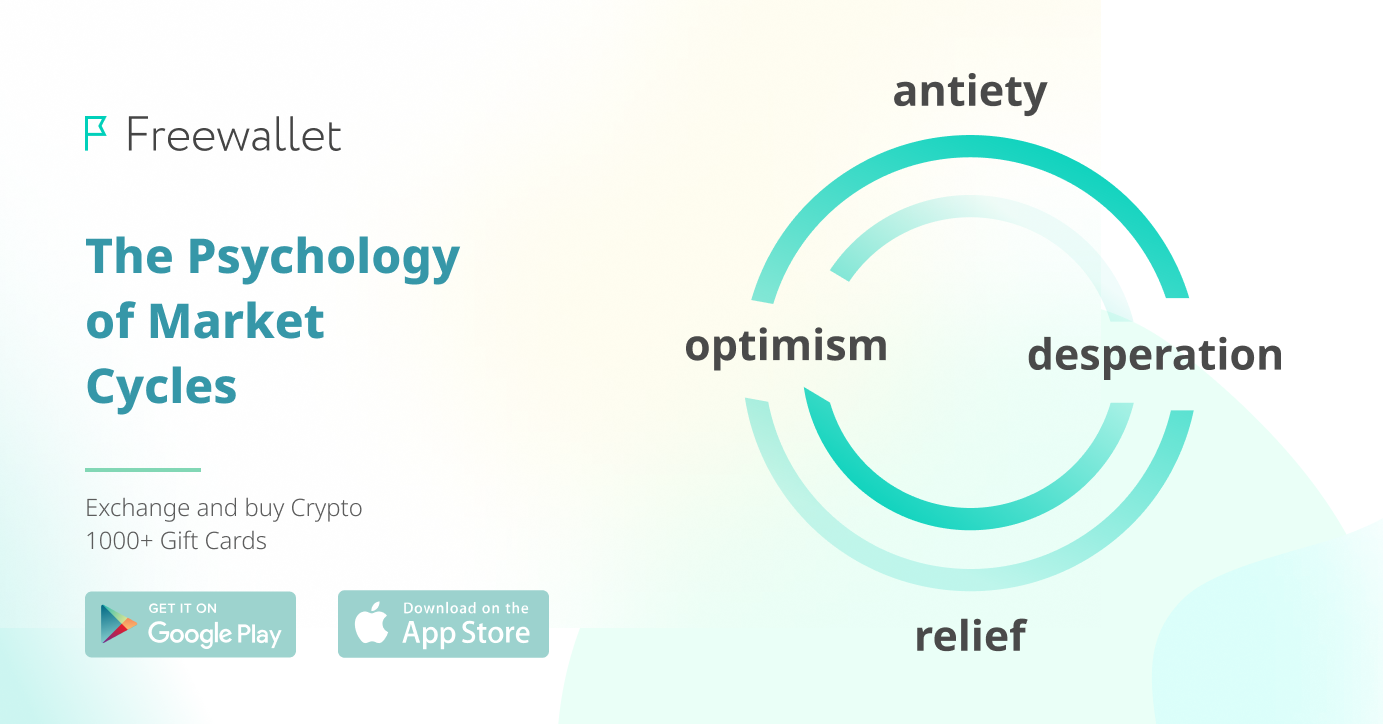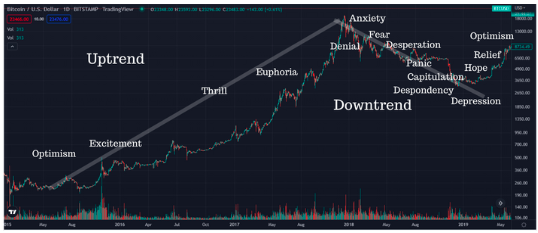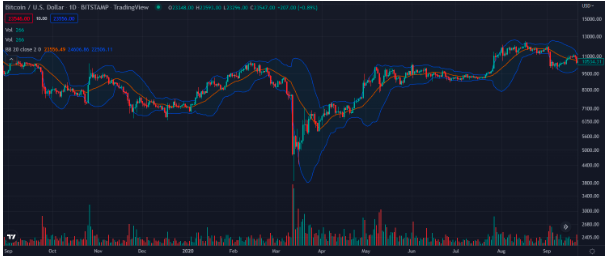
The reason why major investors and analysts like Dow and Elliott were able to reject the Random Walk Theory is that markets move according to human emotions – and they seem to be immutable.
That’s why understanding the psychology of a market cycle allows you to have a hedge as a trader and investor – also in the crypto space.
What is market psychology?
Market psychology is the conviction that any movement in any type of market is the result of the emotion of its participants.
This idea produces a different kind of analysis when looking at markets and their graphic representations – that is, price charts.
How do emotions change during market cycles?
With market psychology, cycles give investors and traders a totally different perspective on what’s going on, and they soon acquire a logical sense – of course, always given that market psychology is not a science and you should always understand if it can fit your needs and trading strategies.
Market cycle psychology assumes that the emotions of traders are completely different when considering uptrends and downtrends.
Uptrend
During an uptrend, positive feelings are in play. Usually, good news supports the beliefs of those who are confident in the rise of the market, and the bullish phase of the market cycle goes ahead.
Of course, uptrends and downtrends are not straight lines because of all of the emotions that influence market behavior – as we’ll see in a while.
Downtrend
All markets are characterized by cycles, and the bullish and bearish phases are the most important parts of these cycles. Downtrends form the bearish phase, and even if this phase is as natural as the bullish one, when it comes to emotional trading, nothing is rational.
The emotions in play are completely different this time – among them, fear, panic, and even desperation.

If we had to look at the very large picture, this image represents – in general terms – a full market cycle. In a while, you’ll see what happens in reality when you take into account all the emotions that can affect trends.
The cycle of investor emotions
As mentioned, trends are not straight lines: they’re fragmented by constant changes, in line with or against the main trend, and this occurs because there are countless emotions involved.
Let’s see the main ones.
Optimism
This is the emotion traders feel when, after a sideways movement – or distribution phase – an asset’s price starts rising.
Excitement
The rise doesn’t stop, and traders feel that they made the right choice.
Thrill
The price continues rising, there is no reason to think about possible negative outcomes.
Euphoria
Traders are really too happy about the success of their investment. The problem is that less experienced traders usually enter the market during this phase because it’s also the moment when good and super hyped news spreads across the web – do you remember ‘Bitcoin 100K’?
Anxiety
Something goes wrong. The euphoric stage led the market to its top – usually with an overbought asset not supported by volume. The price begins to drop.
Denial
Even if the market slows down, traders can’t believe that – and sometimes they’re supported by briefly rising prices that are not supported by volume.
Fear
The price is really going down. Treaders start to think that maybe the movement is real.
Desperation
The price doesn’t recover. At this point, traders are totally confused.
Panic
Maybe there’s nothing to do, and the market is maybe in its bear stage.
Capitulation
Not knowing what to do, traders sell their assets – and in most cases, they lose a lot of money.
Despondency
After such a loss, many traders swear that they’ll never enter the market again.
Depression
This is the time for reflections: how was that possible?
Hope
Since markets naturally move in cycles, there is a point at which the market stops going down and starts a sideways movement – also called the accumulation phase because it’s the stage that the most experienced traders and investors are waiting to buy.
Relief
A new uptrend starts, and those who suffered the loss think that maybe their intuitions were right.
The cycle starts again, as well as all the emotions involved.
From a general representation of a market cycle to what actually happens.
How do investors use market psychology?
Experienced investors often use market psychology to decide when to enter and exit the market.
Basically, what they do is act as observers who avoid emotional trading but use the emotions of less experienced traders and investors to their advantage.
For instance, an experienced trader can usually spot a market stage in which people are totally hopeless and this led to the capitulation of the market.
In this case, while most traders have already sold their assets, the trader who uses the psychology of the market cycle benefits precisely from this stage to buy assets at a discounted price.
But how can experienced traders spot different stages?
Technical analysis and market psychology
Supporters of technical analysis tend to read charts as sort of books where you can find all the info you need to plan your next move.
Market theories based on the analysis of price find in charts the best way to observe how the market – understood as the set of participants involved – is going.
A good example is the Wyckoff strategy: its supporters, by analyzing prices and volume, can follow the rules theorized by the popular investor and set their strategies.
Over time, and also thanks to the advent of digitization, it became easier to use technical analysis and indicators.
For instance, an indicator such as the Bollinger Bands can help you to easily understand when an asset is overbought or oversold – as long as the indicator is set correctly – and this allows you to relate prices to specific emotional stages of the market.

A use case of the Bollinger Bands: the candlestick that breaks the lower band might help you understand that the asset is oversold.
BTC/USD price chart. Source: TradingView.
Bitcoin and market psychology
To better understand how technical analysis and market psychology give you the most relevant trading information, let’s give a practical example using Bitcoin.
Even if there are many reasons why this cryptocurrency is worth so much, it’s also subject to the emotions of traders and its impressive volatility, especially during specific periods, helps us understand why psychology is so important.
The rise and fall of Bitcoin between 2017 and 2018 should be studied by all traders and investors.
Amidst greed and excessive optimism, as well as “Lambos” and stories of people who became rich overnight, the price of Bitcoin started to rise impressively, but there are two things you should notice:
- The price was rising at a relatively low volume;
- The spikes in buying volume weren’t in line with the bodies of the corresponding candlesticks – just to recall Wyckoff.
Everything was showing that the price was supported by emotions: the fall left tons of traders without their funds, and panic and fear led to a tragic capitulation.

BTC/USD price chart 2017/2018. Source: TradingView.
Cognitive biases
The Bitcoin example clearly shows that less experienced traders – or traders who simply give in to emotional trading – are affected by some cognitive biases.
To mention just the most common ones (that also perfectly fit our Bitcoin example):
- Confirmation bias is the tendency to give credit only to all those news and information that confirm our beliefs, completely ignoring what tells us that maybe we’re wrong.
- The endowment bias is the tendency to value the assets we own, ignoring all other assets and maybe assigning to ours a value that it’s not backed by facts. This may lead to losing great opportunities and to hodl digital assets that are not worth it.
Conclusion
Emotional trading can be extremely dangerous to those who have not great experience as traders but extremely profitable to those who understand the psychology of market cycles!
Related
Stay tuned
Subscribe for weekly updates from our blog. Promise you will not get emails any more often.
Most Popular
New Posts
Stay tuned
Subscribe for weekly updates from our blog. Promise you will not get emails any more often.





